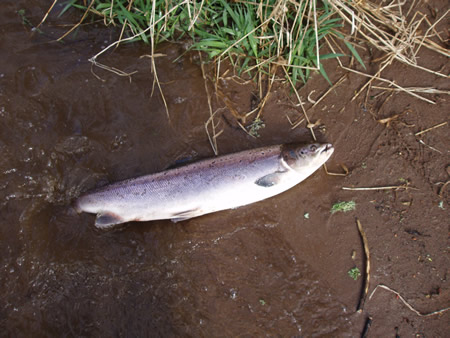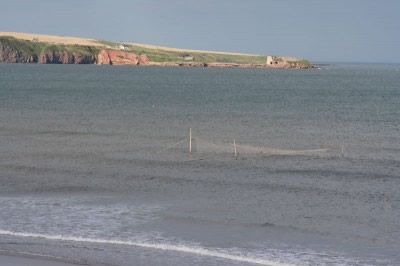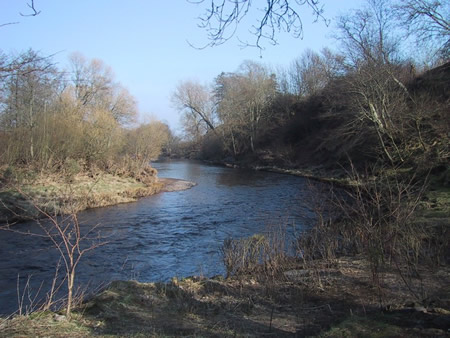These bulletin blogs represent news about Finavon and the South Esk, and my views as a riparian owner. They are not the views of any other organisation, nor are they designed to promote the interests of any individual or organisation other than Finavon Castle Water and factors affecting the fishery. Tony Andrews
I think there are quite a few people who may be disappointed with this week’s report from the Montrose team of scientists on the movements of our tagged salmon. You may recall that last week, with the wind in the East, no fish were caught in the Usan nets. The week just gone (ended Friday 13th April) has seen more fish tagged to a total of 59 radio-tagged fish to date.
Despite the little freshet in the South Esk last week, there have been no more movements of tagged salmon recorded by the strategically placed receivers on the South Esk. We still await reports from the North Esk, Tay and Dee, but it does look as if last week’s higher water levels failed to encourage new fish into the river – at least not the 47 that were tagged up to the beginning of the week.
While members of the Marine Scotland science team worked long hours to select the best fish for radio tagging, the fish themselves were simply not responding, rather against our expectations. On Monday I will be in touch with the team again to see if there are any late reports of more salmon tagged or movements of the 50 tagged fish that have yet to ‘appear’ on the receivers.
I suppose the moral is that these wild fish will do as they please, We should remember that these salmon are wild animals, recently returned from one of the most astonishing migrations of any living thing. They are hardly going to respond to our attempts to measure and record their movements. Eventually we will continue building the picture of where these MSW spring salmon go to lay their eggs, and we could be surprised. I won’t say that I am disappointed by the dirth of recorded movement, but I will say that of the 59 so far tagged we only have 9 recorded, and three of these fish appear to have returned to the sea after a brief foray up the South Esk.
This 12lbs hen salmon was caught by Derek Strachan in Tyndals on the 12th of April 2012. The fish had been in the river for some time and there were signs of healed lesions and possible recovery from saprolegnia. Assuming that it succeeds in spawning this fish should deposit in the order of 6,000 eggs.
Fish have been seen at Finavon during the week, a couple lost (one in Melgund Pool on Castle Beat and the other in Volcano on Milton Beat) and salmon of 12lbs and 9lbs caught and returned, both from Tyndals Pool (Milton Beat). Interestingly these were both fish that had been in the river for some weeks and both were marked by lesions and fungus that had started to heal. They were caught on a small fly quite well down in Tyndals, which is surprising given the relatively low level of the river. As Derek, who caught both fish said, there are bound to be fish in other pools keeping a low profile in these summer low levels. I also note that Cortachy and Downie Park have caught 4 salmon this week, but that Inshewan has not scored, although fish there have been hooked and lost. From further down river Doug Scott reports fish running through the Brechin Angling Club water and Charles Gow, the factor at Kinnaird said that he thought there were plenty of fish in the river.
Late this afternoon (14/4) Moray found a large dead salmon beside the river at Nine Maidens (Castle Beat). It was such a fine fish, although covered with saprolegnia fungus, that Moray asked me to see it. We measured its length (37″) and its girth (19″). This cock salmon was bright silver but without sea lice, and in first class condition. Moray and I agreed that it weighed at least 20lbs. We checked its stomach for any sign of a radio tag, but there was none. We also took some scales to send to Gordon Smith at the Montrose office of Marine Scotland Science.
TA on 14/4/2012
Update on 16/4/2012. By Friday evening (14/4) about 65 salmon had been fitted with radio tags (exact number to be confirmed later this week), but, as before, there are no reports of fish being picked up by receivers on Dee, North Esk or Tay. There was some movement of fish within the South Esk, but this was minimal and probably not significant. Some people may be thinking that we are not learning much from this exercise, but I think that may be a bit pessimistic on the grounds that current conditions are not very helpful, with an east wind blowing onshore, cold and low water, and salmon probably moving offshore to await more favourable conditions.
I also find it highly significant that not one salmon out of approaching 70 tagged fish has been recorded in any of the neighbouring rivers. With the target of 150 salmon radio tagged by the end of May we are approaching the halfway point with seven weeks to go. A sample of 150 tagged fish is quite significant and has the potential to tell us a lot about the geographical dispersal of our spring salmon within the South Esk catchment.
TA



